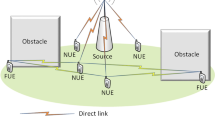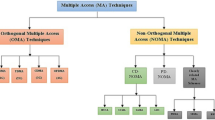Abstract
A novel cooperative diversity scheme based on Distributed Space-Time Block Coding and Multi-Carrier Code Division Multiple Access (DSTBC-MC-CDMA) is proposed which works well in frequency selective fading channels with multiple single-antenna users. And an analytical error model is established to describe the symbol decoding errors between interusers, based on which a close form expression for theoretical Bit Error Rate (BER) performance of the scheme is derived to analyze the influence of the interuser decoding errors on the BER performance of the scheme. Then simulation is complimented to verify the analytic result above, which also shows that the BER performance of DSTBC-MC-CDMA outgoes that of non-cooperative MC-CDMA with considerable gains. Furthermore, the simulations coincide with the theoretical results well.
Similar content being viewed by others
References
C. R. Dow, P. J. Lin, S. C. Chen, J. H. Lin, and S. F. Hwang. A study of recent research trends and experimental guidelines in mobile ad-hoc network. Advanced Information Networking and Applications’ 2005, Taipei, China, 2005, 72–77.
A. Bletsas, A. Khisti, D. Reed, and A. Lippman. A simple cooperative diversity method based on network path selection. IEEE JSAC, 24(2006)3, 659–672.
Qinye Yin, Ying Zhang, et al. Cooperative diversity: A new spatial diversity technique. Journal of Xi’an Jiaotong University, 39(2005)6, 552–557 (in Chinese). 殷勤业, 张 莹, 等. 协作分集: 一种新的空域分集技术. 西安交通大学学报, 39(2005)6, 552–557.
A. Nosratinia, T. E. Hunter, and A. Hedayat. Cooperative communication in wireless networks. IEEE Commun. Mag., 42(2004)10, 74–80.
T. Cover and A. E. Gamal. Capacity theorems for the relay channel. IEEE Trans. on Inform. Theory, 25(1979)5, 572–584.
A. Sendonaris, E. Erkip, and B. Aazhang. Increasing uplink capacity via user cooperation diversity. IEEE International Symposium on Information Theory, Cambridge, MA, USA, 1998, 156–156.
A. Sendonaris, E. Erkip, and B. Aazhang. User cooperation diversity Part I: System description. IEEE Trans. on Commun., 51(2003)39, 1927–1937.
A. Sendonaris, E. Erkip, and B. Aazhang. User cooperation diversity Part II: Implementation aspects and performance analysis. IEEE Trans. on Commun., 51(2003)11, 1939–1948.
J. N. Laneman. Cooperative diversity in wireless networks: Algorithms and architectures. [Ph.D. dissertation], MIT, Cambridge, MA, 2002.
J. Laneman, G. Wornell, and D. N. C. Tse. An efficient protocol for realizing cooperative diversity in wireless networks. IEEE International Symposium on Information Theory, Washington D.C., 2001, 294–294.
J. N. Laneman, D. N. C. Tse, and G. Wornell. Cooperative diversity in wireless networks: Efficient protocols and outage behavior. IEEE Trans. on Inform. Theory, 50(2004)12, 3062–3080.
J. N. Laneman and G. W. Wornell. Exploiting distributed spatial diversity in wireless networks. Allerton Conf. on Comm., Control, and Computing, Allerton Park, IL, USA, October 2000, 775–784.
S. Barbarossa, L. Pescosolido, D. Ludovici, L. Barbetta, and G. Scutari. Cooperative wireless networks based on distributed space time coding. International Workshop on Wireless Ad-hoc Networks, Taiwan, China, 2004, 30–34.
S. Barbarossa and G. Scutari. Cooperative diversity through virtual arrays in multihop networks. ICASSP’2003, Hong Kong, China, 2003, 2387–2399.
S. Barbarossa and G. Scutari. Distributed space-time coding strategies for wideband multihop networks: Regenerative vs. non-regenerative relays. ICASSP’04, Montreal, Canada, 2004, iv-501–iv-504.
P. A. Anghel, G. Leus, and M. Kaveh. Multi-user space-time coding in cooperative networks. ICASSP’03, Hong Kong, China, 2003, iv-73–iv-76.
P. A. Anghel and M. Kaveh. On the diversity of cooperative systems. ISSAP’04, Montreal, Quebec, Canada, 2004, 577–580.
Author information
Authors and Affiliations
Corresponding author
Additional information
Supported by the National Natural Science Foundation of China (No.60372107).
About this article
Cite this article
Zhao, X., Zheng, B. The theoretical BER performance analysis of a cooperative diversity scheme in frequency selective fading channel. J. Electron.(China) 24, 740–747 (2007). https://doi.org/10.1007/s11767-006-0063-z
Received:
Revised:
Issue Date:
DOI: https://doi.org/10.1007/s11767-006-0063-z
Key words
- Cooperative diversity
- Theoretical Bit Error Rate (BER)
- Distributed Space-Time Block Coding (DSTBC)
- Multi-Carrier Code Division Multiple Access (MC-CDMA)
- Frequency selective fading channel




